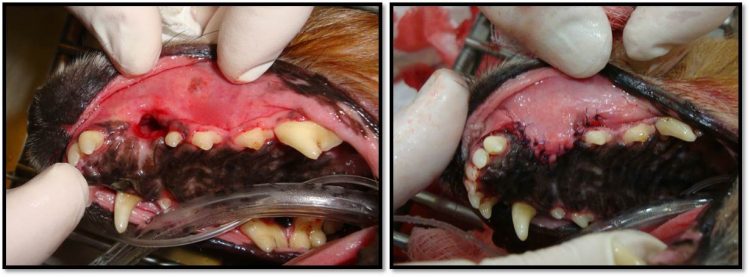
Oronasal Fistulas
An oronasal fistula is a pathologic communication between the mouth and nasal cavity. They can develop secondary to trauma, neoplasia, immune-mediated disease and most commonly secondary to advanced periodontal disease. Smaller long-nosed breeds, such as Dachshunds, Italian Greyhounds, Chihuahuas and miniature Poodles are most prone as there are only a few millimeters of bone separating the tip of the root of the maxillary canine teeth from the floor of the nasal passages.
Common clinical signs include sneezing, nasal discharge (clear, mucus, blood) or pawing at the face. Oronasal fistulas should be suspected whenever there is mobility, severe gingival recession or deep pocketing around the maxillary canine teeth. These lesions do not heal on their own and are a constant source of infection and inflammation for the nose. Surgical correction is the only treatment option. Flaps are created using the inside lining of the mouth and lip which extends over the fistula site and is attached to the hard palate.
In order to help prevent the formation of oronasal fistulas, daily dental homecare is necessary for any dog, especially those with a history of periodontal disease. This includes daily toothbrushing, appropriate dental treats and products. Routine oral exams with your veterinarian, every 6-12 months, are necessary to identify any abnormalities in the mouth and if a professional dental cleaning is necessary. For a complete list of all recommended dental products visit, www.VOHC.org.